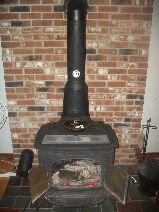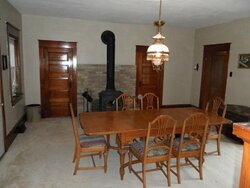Hello, name here is Larry. I've been reading several threads here, and although there is a wealth of information, I figured I'd run my questions by everyone just in case I may have missed something.
First, I live in a Cape which was built in 1977. The chimney is brick/clay, and is about 28 feet tall. unfortunately, it's located on the steep side of the roof where the only access is via 32' ladder. Not that I'm afraid of heights, but the storms we get here in New England force me to clean the chimney on "good" days. Anyways, the flue comes through the brick wall about 6 feet from the floor of the 1st floor living room, and elbows down to the Vigilant. Forgetting about my questions for a minute, when this stove is running around 350deg, it heats the house very well, and both the wife (city girl) and myself enjoy the heat very much!
I've noticed a couple of issues with the stove though. Supposedly, when the stove is up around 450 - 500 degrees, you're supposed to be able to close the damper on the stove, and that allows the heat to reburn the smoke and gasses for a cleaner exhaust. When I try this (even with a good bed of coals), the stove cools right down to about 250 degrees. Yes, I've had a problem with creosote building up on the flue because I would fill the stove for the long evening burns. As much as I like to have coals there waiting for the first morning log to be put on, I don't like the cold flue temperatures - and I have the creosote to prove why.
My first question is - is it normal for the flue to cool down ~250 degrees with the damper shut? Is it adjustable internally somehow? I've even tried opening up the main and secondary air inlets all the way to see if that helps, but the fire just seems to smolder all night.
I appreciate any help you may offer. I need to use the wood so I can offset the oil bill this year - I just don't want to burn the house down in the process!
I also don't want to "overdo" my first post so I think I'll save the other questions for another time.
Larry
First, I live in a Cape which was built in 1977. The chimney is brick/clay, and is about 28 feet tall. unfortunately, it's located on the steep side of the roof where the only access is via 32' ladder. Not that I'm afraid of heights, but the storms we get here in New England force me to clean the chimney on "good" days. Anyways, the flue comes through the brick wall about 6 feet from the floor of the 1st floor living room, and elbows down to the Vigilant. Forgetting about my questions for a minute, when this stove is running around 350deg, it heats the house very well, and both the wife (city girl) and myself enjoy the heat very much!
I've noticed a couple of issues with the stove though. Supposedly, when the stove is up around 450 - 500 degrees, you're supposed to be able to close the damper on the stove, and that allows the heat to reburn the smoke and gasses for a cleaner exhaust. When I try this (even with a good bed of coals), the stove cools right down to about 250 degrees. Yes, I've had a problem with creosote building up on the flue because I would fill the stove for the long evening burns. As much as I like to have coals there waiting for the first morning log to be put on, I don't like the cold flue temperatures - and I have the creosote to prove why.
My first question is - is it normal for the flue to cool down ~250 degrees with the damper shut? Is it adjustable internally somehow? I've even tried opening up the main and secondary air inlets all the way to see if that helps, but the fire just seems to smolder all night.
I appreciate any help you may offer. I need to use the wood so I can offset the oil bill this year - I just don't want to burn the house down in the process!
I also don't want to "overdo" my first post so I think I'll save the other questions for another time.
Larry



 . Thanks for the tip on removing it!
. Thanks for the tip on removing it!
